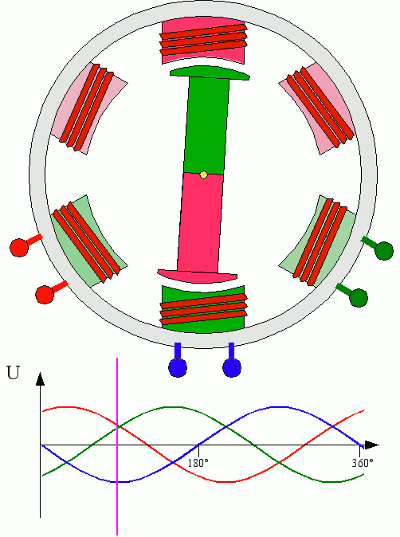|
|
|
|
News The Project Technology RoboSpatium Contribute Subject index Download Responses Games Gadgets Contact <<< AC motor Asynchronous motor >>> Synchronous motorThree-phase electric powerThe voltage progression of sinusoidal alternating voltages is often plotted versus angular dimensions instead of time:
Voltage curve of a sinusoidal AC voltage: One period equals 360 degrees. Three-phase electric power consists out of three single alternating currents with same frequency and a phase shift of 120 degrees (=360° / 3): 
3-phase electric power: The power in a three-phase circuit is carried by three wires called phase and one additional neutral wire ("negative terminal"). Three-phase AC synchronous motorThree phase-electric voltage can be used to power electric motors. For that purpose each phase is connected to an inductor (or a pair of inductors) by what a magnetic field with varrying strength and polarity is generated. The magnetic fields change their direction and strength periodically with a constant speed which generates a rotating magnetic field. The poles of the magnetic field "move" around the axis of the motor. The rotor (electrically excited or a permanent magnet) is attracted by the rotating magnetic field and starts rotating in a synchronous manner. The rotational speed is given by the frequency of the alternating current and the number of poles respectively inductors of rotor and stator. If the frequency of the alternating current exceeds the rotational speed given by the construction respectively the load, the motor starts vibrating as described in the chapter about stepper motors.If a permanent magnet is used as rotor, the motor doesn't need sliding contacts to operate which makes it nearly free from mechanical wear. Machines like this are called brushless motors. 
3-phase AC synchronous motor: Three pairs of electromagnets at the stator and a single permanent magnet as a rotor gives a rotational speed being equivalent to the frequency of the alternating current. With 6 pairs of electromagnets the rotational speed would become half the frequency of the alternating current. <<< AC motor Asynchronous motor >>> News The Project Technology RoboSpatium Contribute Subject index Archives Download Responses Games Links Gadgets Contact Imprint |
|
|